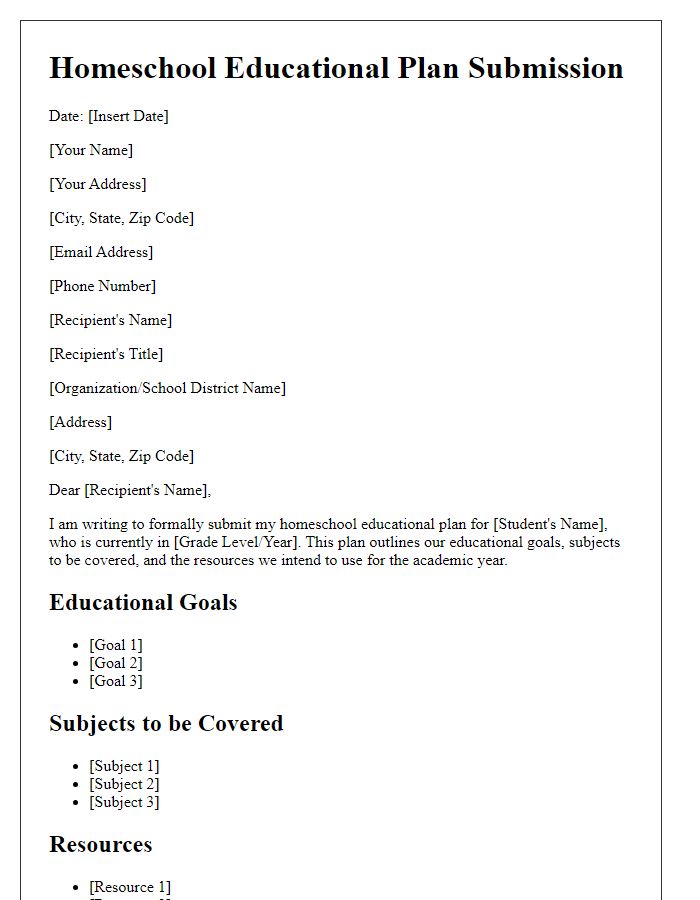Hey there! If you're considering homeschooling your child and need to get your curriculum approved, crafting a well-structured letter is essential. This letter not only outlines your educational plan but also highlights the benefits of your chosen curriculum for your child's growth. It's an important step in ensuring that you meet the necessary regulations while providing a tailored learning experience. Want to learn how to write the perfect letter for homeschool curriculum approval? Read on!

Educational Objectives and Goals
Homeschool curriculum approval requires a clear articulation of educational objectives and goals. Establish essential subject areas, like Mathematics, Science, Literature, and Social Studies, focusing on grade-level standards. Each subject should aim to foster critical thinking, problem-solving skills, and effective communication. Set specific goals, such as achieving proficiency in basic arithmetic operations by the end of the academic year or understanding the fundamental principles of physics through hands-on experiments. Additionally, include objectives related to personal development, such as cultivating a love for reading and engaging in community service projects to enhance social responsibility. Emphasizing measurable outcomes, like completion of standardized assessments, ensures alignment with educational expectations.
Curriculum Content and Subjects
Homeschool curriculum approval often requires detailed documentation of curriculum content and subjects to ensure compliance with educational standards. The chosen curriculum should encompass core subject areas such as Mathematics, Science, Language Arts, and Social Studies, along with elective subjects like Art or Foreign Languages. Specific grade-level objectives need to be outlined, indicating skills and knowledge expected for students, such as elementary math involving addition and subtraction, or middle school science covering topics like ecosystem dynamics. Additional resources, including textbooks like "Math in Focus" or digital platforms like "Khan Academy," should be specified to support the curriculum. Assessments and progress tracking methods, such as quarterly reports or standardized tests, must also be included to demonstrate student learning outcomes and adherence to educational benchmarks.
Teaching Methods and Resources
Homeschooling families often utilize diverse teaching methods and resources to effectively educate their children. Common approaches include classical education, which emphasizes the Trivium (grammar, logic, rhetoric), and the Montessori method, focusing on hands-on learning and self-directed activity. Online platforms, such as Khan Academy and Coursera, provide interactive lessons and assessments suitable for various subjects and age groups. Various educational resources like workbooks, flashcards, and multimedia presentations aid in reinforcing learning concepts. Local libraries often serve as valuable partners, offering books, study materials, and resources for project-based learning. Incorporating field trips to museums, science centers, and historical sites enriches the educational experience by providing real-world context, enhancing retention, and fostering a love for learning.
Evaluation and Assessment Plan
Homeschool curriculum assessment involves a detailed evaluation strategy designed to monitor student progress. Standardized testing, such as the Stanford Achievement Test, offers quantifiable measures of academic performance. Formative assessments, including quizzes and oral presentations, enable real-time feedback to adapt teaching methods effectively. Summative assessments, like end-of-year projects, provide comprehensive insights into knowledge retention. Additionally, regular portfolio reviews featuring writing samples, completed assignments, and creative projects ensure a holistic view of student achievement over the academic year. Incorporating peer assessments encourages collaborative learning and critical thinking skills. Documenting these evaluations in a dedicated portfolio reflects the ongoing educational journey for each student.
Compliance with State Regulations
Homeschool curriculum approval requires adherence to specific state regulations that vary widely depending on jurisdiction. Detailed documentation of educational objectives and instructional methods must reflect state benchmarks. Submitting a sample curriculum outlining subjects such as mathematics, language arts, science, and social studies is essential. States like Texas demand portfolios showcasing student progress through state-specified assessments, while California requires annual notification and educational materials that align with grade-level expectations. Additional elements may include evidence of parent qualifications, educational philosophies, and plan for instructional hours, typically ranging from 900 to 1,080 annually for grades K-12. Compliance with these regulations ensures not only legitimacy in educational practices but also provides a structured learning environment that meets legal standards.













Comments